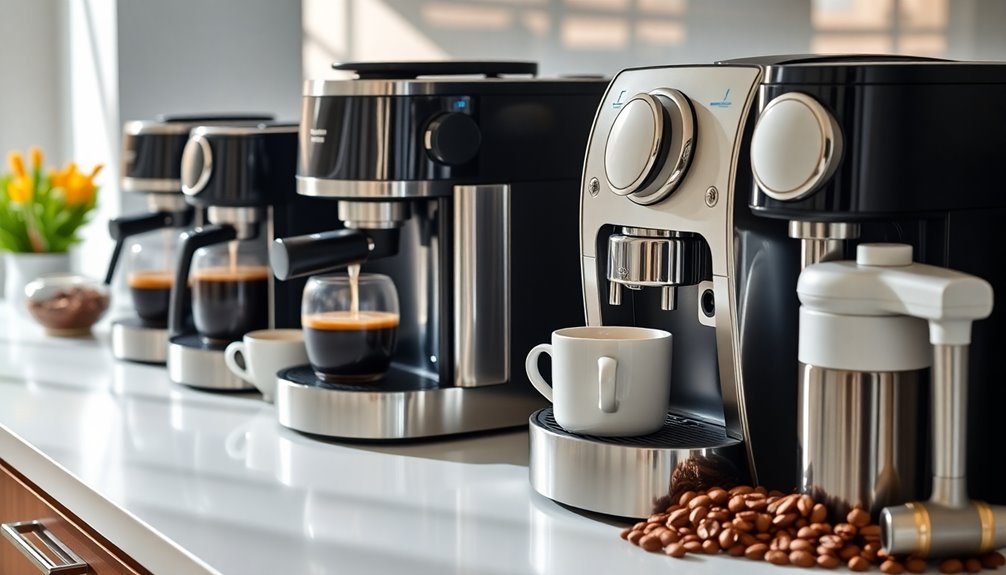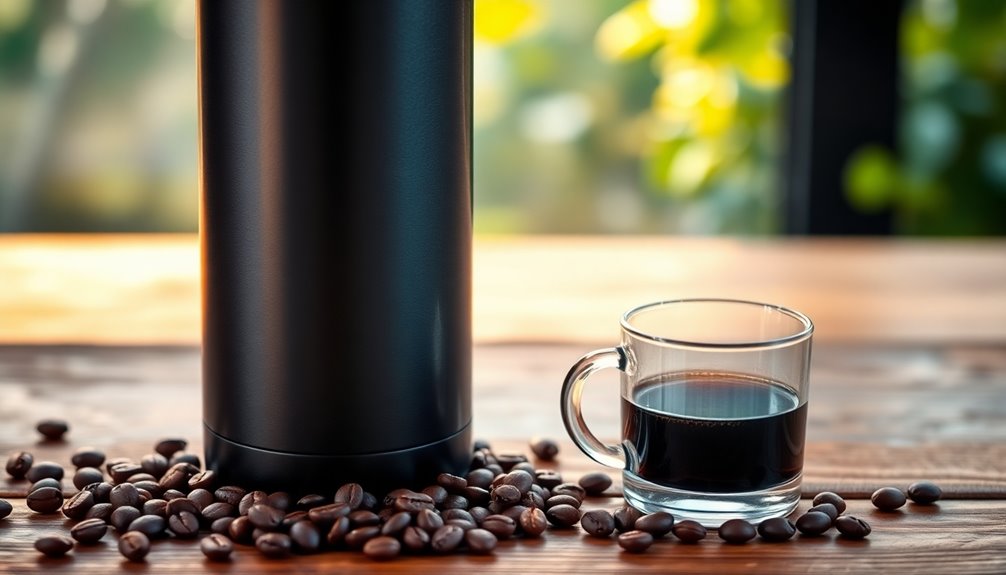Choosing the right portafilter is crucial for achieving your espresso goals. Start by considering the material; high-quality options like brass or stainless steel ensure better heat retention. Size matters too—most machines operate with a 58mm portafilter, which can enhance flavor extraction. Think about the type of basket: pressurized ones help beginners, while non-pressurized options cater to advanced users seeking control. Additionally, standard portafilters keep the mess down, while bottomless versions let you monitor your extraction. Picking the right combination elevates your espresso game, and there's much more to explore for perfect brews ahead.
Key Takeaways
- Determine your machine's compatibility by confirming it requires a 58mm portafilter for optimal extraction and flavor.
- Choose between pressurized baskets for beginners or non-pressurized options for advanced control over espresso quality.
- Select high-quality materials like chrome or brass for better heat retention and durability in your portafilter.
- Consider the design, such as standard or bottomless, to enhance your extraction experience and simplify maintenance.
- Regularly maintain your portafilter to ensure consistent performance and prevent issues that affect extraction quality.
Understanding Portafilter Materials

When choosing a portafilter for your espresso machine, it's essential to understand the materials used in its construction. High-end portafilters are typically made from chrome, brass, or stainless steel, offering excellent heat retention and durability. These materials keep your coffee hot during extraction, ensuring consistent shots. Their long-lasting quality withstands the high pressures of espresso making, while full-grain wood or high-end metal handles add a touch of elegance. On the other hand, entry-level portafilters often use thin aluminum and plastic handles. While they're cost-effective, they lack thermal stability and heat retention, which can affect your espresso's consistency. Understanding these differences helps you choose a portafilter that aligns with your brewing goals and budget. Additionally, the industry standard size for portafilters is 58 mm, making it a crucial factor in selecting the right equipment for your espresso needs.
Importance of Portafilter Size

Understanding the importance of portafilter size is crucial for achieving the best espresso results. Your espresso machine specifications dictate the portafilter size you can use. For instance, commercial-grade machines typically require 58mm portafilters, while machines like the La Marzocco Linea Mini utilize 54mm ones.
Using an incompatible portafilter can hinder your machine's performance. Larger portafilters allow for greater coffee ground capacity, enhancing flavor and aroma extraction. This means better crema and extraction quality, especially with consistent water flow. Additionally, the industry standard favors 58mm portafilters in commercial settings, making them a more future-proof choice.
For home use, smaller portafilters are ideal for single shots. Ultimately, choosing the right size not only affects extraction but also aligns with your brewing needs, ensuring you get the most out of your coffee beans.
Features of Standard Portafilters

Choosing the right portafilter size sets the stage for exploring the features of standard portafilters.
These portafilters typically come with spouts that direct espresso cleanly into one or two cups, ensuring a mess-free experience. Their enclosed design aids in heat retention during extraction, enhancing the quality of your brew.
Made from durable materials like stainless steel, they often feature a flat base for stable tamping. Dual-shot capabilities allow you to split double shots easily, controlling the flow for better crema.
They're user-friendly, minimizing spills and forgiving minor errors, making them ideal for beginners. Additionally, the pressurized basket design is particularly beneficial for those new to espresso brewing as it helps control shot flow and consistency. Plus, they fit various espresso machines, ensuring consistent results that elevate your brewing experience.
Advantages of Bottomless Portafilters

While standard portafilters have their merits, bottomless portafilters offer unique advantages that can significantly elevate your espresso-making experience.
They provide a clear view of the coffee bed during extraction, allowing you to observe ground distribution and puck formation. This visibility helps detect channeling and uneven extraction, enabling real-time troubleshooting of any issues. The visual feedback from a bottomless design allows for adjustments based on the extraction variables affecting espresso quality.
You'll find that using a bottomless portafilter encourages even distribution of coffee grounds and consistent tamping pressure, which enhances your technique and overall espresso quality.
Additionally, you'll maximize crema production by facilitating even extraction, while also simplifying maintenance since there are no spouts to trap coffee residues.
With these advantages, you'll develop better skills and consistency in every cup you brew.
Pressurized Vs Non-Pressurized Options

As you explore your options for espresso-making, you'll quickly notice the debate between pressurized and non-pressurized portafilters.
Pressurized portafilters, designed with a unique filter basket, create back pressure to help you achieve decent shots even with inconsistent grind or tamping. They're forgiving and ideal for beginners, but they limit your ability to fine-tune flavors. Additionally, pressurized baskets may operate at approximately 12 bars, which can affect the extraction process.
On the other hand, non-pressurized portafilters give you full control over pressure, requiring precise grind and tamping. This option demands more skill but rewards you with vibrant, nuanced espresso that reflects your technique.
If you’re serious about exploring the depths of espresso quality, investing in a non-pressurized portafilter might be your best bet. When using a non-pressurized portafilter, you’ll have more control over the extraction process, allowing you to truly perfect your espresso shots. To complement your new portafilter, consider investing in the best espresso tampers. A high-quality tamper will ensure that your coffee grounds are evenly packed and level, resulting in a more consistent and flavorful espresso. The combination of a non-pressurized portafilter and the best espresso tampers will take your coffee game to the next level.
Compatibility With Your Espresso Machine
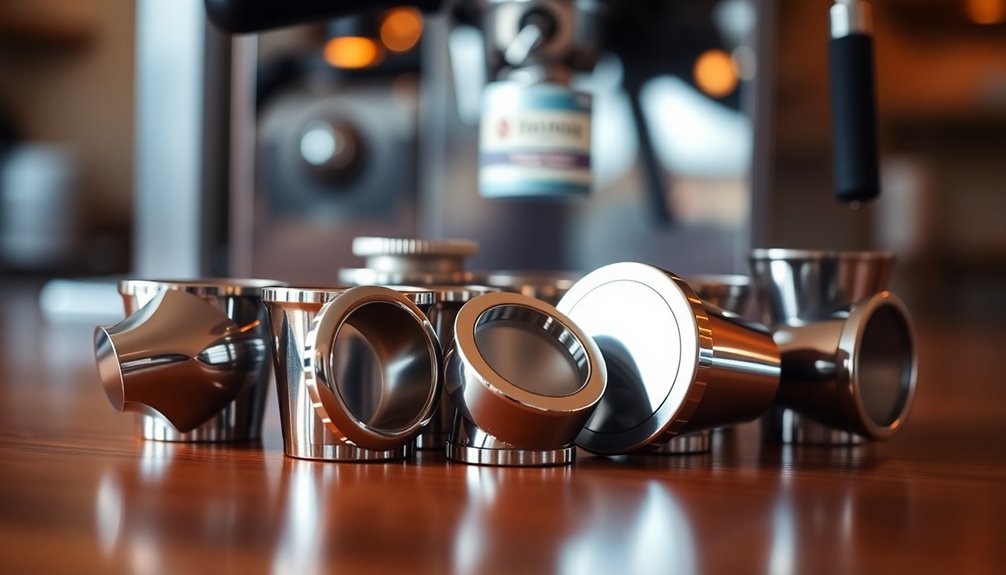
Finding the right portafilter for your espresso machine is crucial to ensuring a seamless brewing experience.
Start by measuring the diameter of your group head to find the compatible size—common options are 51mm, 54mm, and 58mm. For instance, a 51mm portafilter fits machines like the DeLonghi Dedica, while a 58mm suits commercial machines. A good tamper is also essential for optimal results with your portafilter.
Always refer to your machine's manual or compatibility charts for guidance, as some portafilters are brand-specific. If you face a size mismatch, consider using adapters or modifications, but be cautious as these can void warranties.
Finally, ensure the portafilter includes the right basket size for your preferred shot type, as this can significantly impact your espresso experience.
Tips for Optimal Extraction
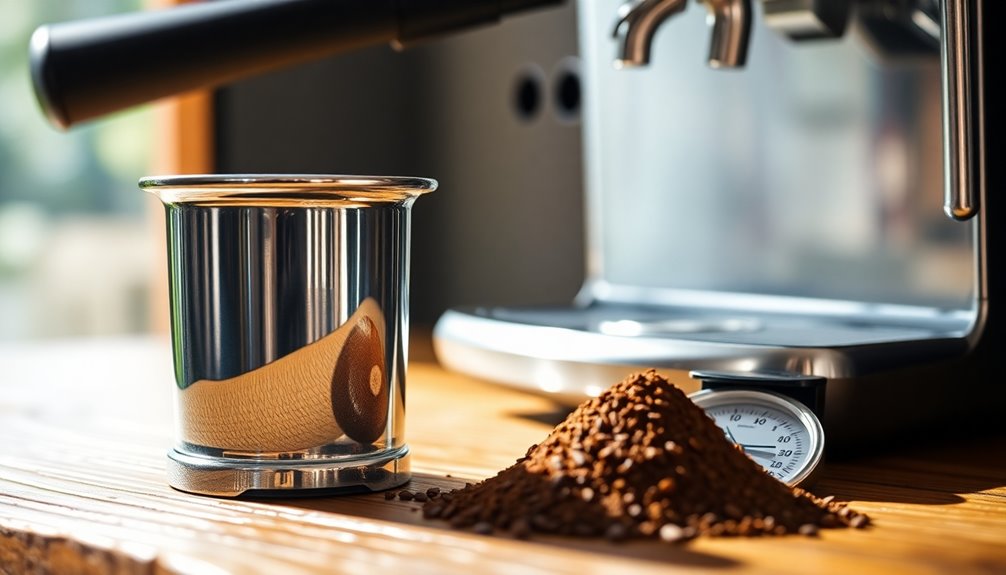
To achieve the best espresso extraction, it's essential to focus on several key factors that can greatly influence the final flavor.
Start with grind size; aim for a fine, consistent grind that allows for resistance without clogging. A double shot should use an 18-20 gram dose, balancing between too much coffee, which leads to bitterness, and too little, which results in a weak taste. Consistency in extraction time is vital to ensuring the espresso's flavor profile remains balanced and enjoyable.
Water temperature should be between 190-205°F (88-96°C) with a pump pressure of around 9 bars to extract soluble compounds effectively.
Lastly, ensure your tamping is firm and level; this promotes uniform extraction and prevents channeling.
Enhancing Your Espresso Experience
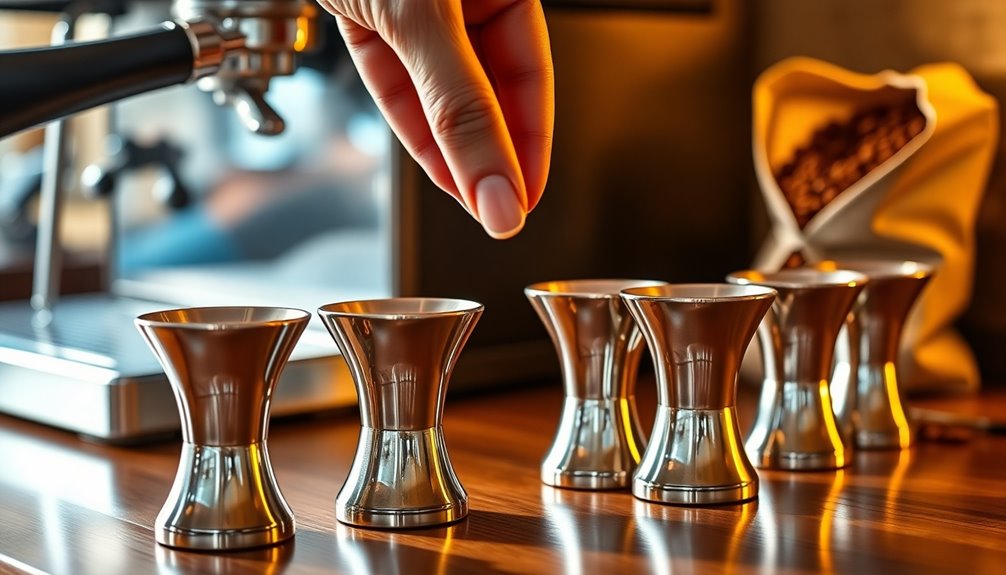
After mastering the art of espresso extraction, enhancing your overall espresso experience becomes the next exciting step.
Choose the right portafilter type to suit your style—whether it's a single, double, or even bottomless for that visual flair. Pay attention to the diameter and compatibility with your machine for a seamless fit. Machine compatibility is crucial, as different machines require specific portafilter sizes to ensure optimal extraction.
Experiment with ridged versus ridgeless baskets; they can impact your extraction quality significantly. If you're a beginner, consider pressurized baskets for consistency.
Don't forget about maintenance—replace worn-out portafilters and think about upgrading to non-pressurized options as your skills grow.
Consulting compatibility charts and coffee experts can guide your choices and elevate your home brewing. Enjoy the journey of refining your espresso experience!
Frequently Asked Questions
Can I Upgrade My Existing Portafilter for Better Espresso Quality?
Yes, you can definitely upgrade your existing portafilter to enhance espresso quality.
Consider switching to a larger size, like 58mm, for better flavor extraction and consistency. Precision baskets can minimize hole variability, leading to more even extraction.
You might also try a bottomless portafilter, which helps diagnose any brewing issues.
Just make sure the new portafilter fits your espresso machine's group head, and enjoy the improved espresso experience!
How Often Should I Clean My Portafilter for Optimal Performance?
You should clean your portafilter after every use to maintain optimal performance.
Rinse it thoroughly with water to remove coffee residues, and soak it in a cleaning solution weekly.
Scrubbing the portafilter and baskets helps keep oils and buildup at bay.
Additionally, inspect and clean it monthly with specialized products to ensure longevity.
Regular maintenance prevents clogs and ensures your espresso tastes its best every time you brew.
What Are the Benefits of Using a Weighted Portafilter?
Using a weighted portafilter offers several benefits.
You'll find it easier to handle and tamp, reducing wrist strain. The balanced weight promotes consistent tamping pressure, ensuring even extraction every time.
Plus, you'll experience less fatigue during long brewing sessions. The durable materials mean it'll withstand wear and tear while maintaining performance.
Ultimately, you'll enjoy enhanced flavor profiles and more precise control over your espresso, leading to consistently excellent results.
Can I Use a Non-Standard Portafilter With My Machine?
You can't use a non-standard portafilter with your machine without risking compatibility issues.
Each portafilter is designed for specific group heads and diameters, like 58mm or 54mm.
If you try to force a mismatched portafilter, you'll likely face poor extraction and potential damage.
Always measure your machine's brew group and consult compatibility charts to ensure you get the right fit for optimal espresso quality.
Don't skip this step!
How Do Different Portafilter Designs Affect Espresso Flavor?
Different portafilter designs significantly affect your espresso flavor.
Non-pressurized portafilters give you more control, allowing for optimal flavor extraction through precise tamping. In contrast, pressurized versions simplify the process for beginners but can mask nuances in taste.
Additionally, bottomless portafilters enhance your ability to observe extraction, promoting even flavor and richer crema.
Ultimately, the design you choose directly influences the richness and quality of your espresso shots.
Conclusion
Choosing the right portafilter can make all the difference in your espresso journey. Whether you prefer the classic feel of a standard portafilter or the clarity of a bottomless one, understanding materials and sizes is crucial. Don't overlook the pressurized versus non-pressurized options, as they can impact your extraction. By considering compatibility with your machine and applying the tips provided, you can enhance your espresso experience and achieve the rich, flavorful shots you've been aiming for.

